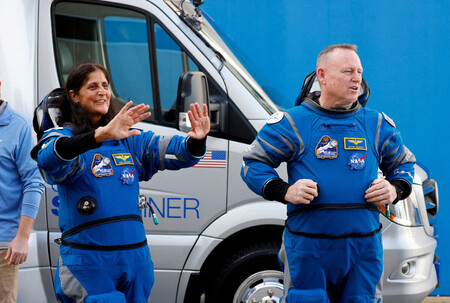In June 2024, NASA astronauts Butch Wilmore and Suni Williams arrived at the International Space Station (ISS) for an 8- to 10-day mission. However, issues with the Starliner spacecraft delayed their return until March 2025, resulting in a stay of 286 days.
What began as a short mission turned into more than nine months of living in microgravity, which can have significant effects on astronauts’ bodies. These includes muscle atrophy, loss of bone density, cardiovascular changes, vision problems, and increased stress.
Below is how Williams and Wilmore looked before they launched into space on the Starliner spacecraft:

And here’s how they looked upon their return on the Crew Dragon spacecraft that rescued them:

Decades of Aging
Both NASA and the European Space Agency have extensively studied the effects of space exposure and microgravity on the human body. One of the most common issues is the loss of muscle and bone mass.
In the ISS, there’s no gravitational force to stimulate muscles and bones, leading to tissue weakening from disuse. Astronauts typically lose about 1% of their bone mineral density for each month spent in space. Additionally, the muscles in their legs and back may atrophy, making it difficult for them to stand upright after returning to Earth.
To counteract bone and muscle loss, ISS crew members follow strict workout routines. They spend two hours daily on the treadmill or exercise bike, and do resistance training. However, studies published in Scientific Reports indicate that a stay of more than six months in space can lead to bone loss equivalent to decades of aging on Earth.
Astronauts often face a higher risk of fractures due to weakened bones, similar to that of elderly people. Wilmore and Williams, with an estimated bone loss of 9-10%, will undergo an intensive 45-day physical rehabilitation program established by NASA. Unfortunately, many astronauts find that their recovery is incomplete even a year after returning home. It may take two to four years for a person’s muscles to fully regain their original strength after a prolonged mission.

Effects of Microgravity
When floating, body fluids are redistributed toward the upper body because gravity doesn’t pull them downwards. This results in the characteristic puffy face often seen on astronauts aboard the ISS. Additionally, the body perceives this fluid shift as an excess and subsequently reduces its total blood volume.
With a lower blood volume and without the need to pump against gravity, the cardiovascular system relaxes. The heart can thin its muscular walls, and blood pressure typically decreases. Upon returning to Earth, this adjustment can sometimes lead to dizziness or even fainting (known as orthostatic hypotension). Gravity causes blood to flow back into the legs, requiring time for the body to readjust.
To mitigate these symptoms, astronauts often wear special compression suits or increase their fluid and salt intake before reentry. Despite this, it’s common for them to remain seated upon landing. Wilmore and Williams did so when they stepped off the Crew Dragon, allowing their bodies to rebalance.
Another significant physical effect identified in recent decades of space exploration is Spaceflight Associated Neuro-Ocular Syndrome (SANS). In a microgravity environment, fluid displacement toward the head can increase intracranial pressure, leading to slight deformation of the eyeballs and compression of the optic nerve. Many astronauts on extended missions report changes in their visual acuity. This can include temporary farsightedness because their eyes change shape under this internal pressure.
More than 70% of astronauts on long-duration missions have experienced SANS. NASA astronaut Scott Kelly, who spent a year in space as part of a study with his twin brother, developed optic nerve edema and retinal changes.
Prolonged weightlessness and the closed environment of the ISS also impact astronauts’ immune systems. This can result in altered distribution of white blood cells and changes in the expression of certain immune genes due to the extreme conditions. Paradoxically, living in the sterilized environment of the ISS may weaken the immune response over time. Without exposure to everyday pathogens, the immune system’s vigilance decreases, leading to skin rashes, allergies, and even reactivation of latent viruses (such as herpes).

Radiation and Psychological Stress
During extended missions, astronauts also accumulate significant exposure to solar radiation and cosmic rays, given that they lack the protection of the Earth’s atmosphere. However, a nine-month stay is within NASA’s acceptable limits because the ISS orbits at an altitude of only 250 miles. Cell damage from radiation exposure will be a much more serious concern for future long-duration space flights to the Moon and Mars.
More concerning are the psychological effects of prolonged confinement on a space station that orbits the Earth 16 times a day. While a strict schedule based on GMT helps manage time, the absence of natural light and dark cycles can disrupt biological rhythms. This can lead to sleep deprivation and impaired cognitive performance.
In the end, the psychological experience of living in a confined environment, away from family, and surrounded by a small group of colleagues from different countries, can take its toll. For Wilmore and Williams, this challenge was intensified by the uncertainty of their mission’s extension due to technical issues and not knowing when they would return home. Wilmore’s daughter said that stress was a significant concern during this time.
Fortunately, most changes to the body that occur in space aren’t permanent. Around 95% of physiological alterations return to normal within weeks of returning to Earth. Astronauts typically regain their balance and ability to walk within a few days, and fluid distribution quickly normalizes. Additionally, sleep disturbances tend to improve once they reestablish terrestrial cycles.
Regarding psychological effects, professional astronauts are selected for their ability to perform well in high-stress situations without becoming overly anxious. It’s both their job and their passion. They don’t receive overtime pay, but whenever the opportunity arises, they’re eager to return to their favorite place: space.
Images | NASA | SpaceX




Log in to leave a comment